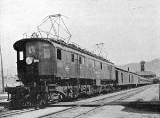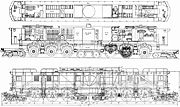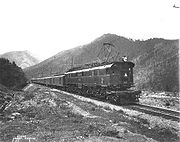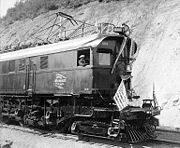
Milwaukee Road class EP-3
Encyclopedia
The Milwaukee Road's class EP-3 comprised ten electric locomotives built in 1919 by Baldwin
and Westinghouse
. They were nicknamed Quills because of their use of a quill drive
. Although they were good haulers and well liked by engineers, poor design and constant mechanical problems plagued them for their entire lives and they were the first of the Milwaukee Road's electric locomotives to be retired.
 When the Milwaukee Road decided to electrify the Coast Division in 1917, it attempted to re-equip with equipment bought from General Electric
When the Milwaukee Road decided to electrify the Coast Division in 1917, it attempted to re-equip with equipment bought from General Electric
. The United States Railroad Administration
, however, dictated that the order for electrical equipment be split between GE and Westinghouse
. This meant that of the 15 electric locomotives needed, five (the EP-2s
, or bi-polars) came from GE and 10 - the EP-3s - came from Westinghouse.
The EP-3s, while designed to meet the same specifications as the bi-polars, were a completely different design from their GE counterparts. Their appearance was sleeker, albeit less distinctive, with a single long boxcab
-style carbody containing all of the electric equipment. Their wheel arrangement
was the same as a back-to-back pair of 4-6-2
"Pacific" steam engines, complete with high 68" drivers
. They were double-ended and designed for high-speed passenger service.
 The most noteworthy aspect of their design was the motor mounting system. The locomotive's six 566 hp traction motors were mounted directly to the frame, one above each driving axle. They were geared to a "quill
The most noteworthy aspect of their design was the motor mounting system. The locomotive's six 566 hp traction motors were mounted directly to the frame, one above each driving axle. They were geared to a "quill
," a steel tube 15 inches in diameter that was mounted around the axle
. At each end of the quill, seven-armed "spiders" stuck out between the spokes of the driving wheels, and were connected to the drivers by coil spring
s. This system, which was later used very effectively on the famous GG1
locomotive, minimized weight suspended directly from the axles, as the traction motors were bolted directly to the locomotive frame.
 The "Quills" entered service between late 1919 and early 1921 and assigned numbers 10300-10309. Assigned mainly to the Mountain Division, they were immediately popular with crews. They could easily pull trains exceeding design specifications at 70-80 mph. They didn't slip like the GE boxcabs and they were much smoother-riding than the bi-polars.
The "Quills" entered service between late 1919 and early 1921 and assigned numbers 10300-10309. Assigned mainly to the Mountain Division, they were immediately popular with crews. They could easily pull trains exceeding design specifications at 70-80 mph. They didn't slip like the GE boxcabs and they were much smoother-riding than the bi-polars.
Within a year of entering service, however, severe design flaws began to become apparent. The EP-3s were virtually identical to the New Haven's class EP-2 locomotives, but were heavier in weight and had a much more lightly built frame. The Milwaukee Road's new EP-3s, unlike the trouble-free New Haven boxcabs of similar design, immediately started experiencing broken axles and frame members, cracked wheels and spokes, and deformed suspension springs.
It was an embarrassment for Westinghouse, which had designed the locomotives far too lightly and rigidly. There was too little lateral play in the drivers, causing excessive wheel wear, and the frames were breaking under the stress of high-speed operation through twisting mountain rights-of-way. During 1922 a series of meetings was held to work on design changes for the locomotives.
Baldwin, which had built the locomotives in conjunction with Westinghouse, recommended splitting the body of the locomotive in two, effectively creating a permanently coupled two-unit boxcab. The Milwaukee Road's Electrification Department under Reinier Beeuwkes had come to differing conclusions about the best course of action to take, and resisted Baldwin's recommendation that all ten "Quills" be cut in two. Instead only one, number 10301, was given this modification. The alteration was not found to help the problems, and it was eventually converted back to single-body configuration.
A second "Quill" was modified to the Milwaukee Road's specifications, and with more success. The entire series was effectively converted to single-end operation and were fitted with Commonwealth Delta idler trucks of better design than the originals to help guide the locomotives into curves. The frames were also completely rebuilt with heavier steel.


 The "Quills" never really met the standards set by their GE-designed counterparts. They were constant headaches for the Milwaukee Road mechanical department and were rebuilt five times during their service lives. They were very heavy and the large drivers were suspected of contributing to frame breakage. They were prone to derailing and their weight tended to increase the severity of such derailments. Locomotive E13 (the "Quills" were renumbered E10–E19 in 1939) was destroyed in a derailment at Soudan, Montana in 1947.
The "Quills" never really met the standards set by their GE-designed counterparts. They were constant headaches for the Milwaukee Road mechanical department and were rebuilt five times during their service lives. They were very heavy and the large drivers were suspected of contributing to frame breakage. They were prone to derailing and their weight tended to increase the severity of such derailments. Locomotive E13 (the "Quills" were renumbered E10–E19 in 1939) was destroyed in a derailment at Soudan, Montana in 1947.
In the late 1940s, with the Little Joes
entering service and the older electric locomotives worn out from heavy use during World War II, the Electrification Department initiated a program to rebuild the Milwaukee Road's electric locomotives for continued service. The "Quills" were not included in the program. Instead, the seven remaining locomotives (three had already been retired due to wrecks) were gradually retired and scrapped between 1952 and 1957.
Baldwin Locomotive Works
The Baldwin Locomotive Works was an American builder of railroad locomotives. It was located in Philadelphia, Pennsylvania, originally, and later in nearby Eddystone, Pennsylvania. Although the company was very successful as a producer of steam locomotives, its transition to the production of...
and Westinghouse
Westinghouse Electric (1886)
Westinghouse Electric was an American manufacturing company. It was founded in 1886 as Westinghouse Electric Company and later renamed Westinghouse Electric Corporation by George Westinghouse. The company purchased CBS in 1995 and became CBS Corporation in 1997...
. They were nicknamed Quills because of their use of a quill drive
Quill drive
A quill drive is a mechanism that allows a drive shaft to shift its position relative to its driving shaft. It consists of a hollow driving shaft with a driven shaft inside it...
. Although they were good haulers and well liked by engineers, poor design and constant mechanical problems plagued them for their entire lives and they were the first of the Milwaukee Road's electric locomotives to be retired.
Design

General Electric
General Electric Company , or GE, is an American multinational conglomerate corporation incorporated in Schenectady, New York and headquartered in Fairfield, Connecticut, United States...
. The United States Railroad Administration
United States Railroad Administration
The United States Railroad Administration was the name of the nationalized railroad system of the United States between 1917 and 1920. It was possibly the largest American experiment with nationalization, and was undertaken against a background of war emergency.- Background :On April 6, 1917, the...
, however, dictated that the order for electrical equipment be split between GE and Westinghouse
Westinghouse Electric (1886)
Westinghouse Electric was an American manufacturing company. It was founded in 1886 as Westinghouse Electric Company and later renamed Westinghouse Electric Corporation by George Westinghouse. The company purchased CBS in 1995 and became CBS Corporation in 1997...
. This meant that of the 15 electric locomotives needed, five (the EP-2s
Milwaukee Road class EP-2
The Milwaukee Road's class EP-2 comprised five electric locomotives built by General Electric in 1919. They were often known as Bipolars, which referred to the bipolar electric motors they used. Among the most distinctive and powerful electric locomotives of their time, they epitomized the...
, or bi-polars) came from GE and 10 - the EP-3s - came from Westinghouse.
The EP-3s, while designed to meet the same specifications as the bi-polars, were a completely different design from their GE counterparts. Their appearance was sleeker, albeit less distinctive, with a single long boxcab
Boxcab
A boxcab, in railroad terminology, is a locomotive in which the machinery and crew areas are enclosed in a box-like superstructure . It is a term mostly used in North America while in Victoria , such locomotives have been nicknamed "butterboxes"...
-style carbody containing all of the electric equipment. Their wheel arrangement
Wheel arrangement
In rail transport, a wheel arrangement is a system of classifying the way in which wheels are distributed beneath a locomotive.. Several notations exist to describe the wheel assemblies of a locomotive by type, position, and connections, with the adopted notations varying by country...
was the same as a back-to-back pair of 4-6-2
4-6-2
4-6-2, in the Whyte notation for the classification of steam locomotives, represents the wheel arrangement of four leading wheels on two axles , six powered and coupled driving wheels on three axles, and two trailing wheels on one axle .These locomotives are also known as Pacifics...
"Pacific" steam engines, complete with high 68" drivers
Driving wheel
On a steam locomotive, a driving wheel is a powered wheel which is driven by the locomotive's pistons...
. They were double-ended and designed for high-speed passenger service.

Quill drive
A quill drive is a mechanism that allows a drive shaft to shift its position relative to its driving shaft. It consists of a hollow driving shaft with a driven shaft inside it...
," a steel tube 15 inches in diameter that was mounted around the axle
Axle
An axle is a central shaft for a rotating wheel or gear. On wheeled vehicles, the axle may be fixed to the wheels, rotating with them, or fixed to its surroundings, with the wheels rotating around the axle. In the former case, bearings or bushings are provided at the mounting points where the axle...
. At each end of the quill, seven-armed "spiders" stuck out between the spokes of the driving wheels, and were connected to the drivers by coil spring
Coil spring
A Coil spring, also known as a helical spring, is a mechanical device, which is typically used to store energy and subsequently release it, to absorb shock, or to maintain a force between contacting surfaces...
s. This system, which was later used very effectively on the famous GG1
PRR GG1
The PRR GG1 is a class of electric locomotives that was built for the Pennsylvania Railroad for use in the northeastern United States. A total of 140 GG1s were constructed by its designer General Electric and the Pennsylvania's Altoona Works from 1934 to 1943....
locomotive, minimized weight suspended directly from the axles, as the traction motors were bolted directly to the locomotive frame.
Design flaws and rebuilding

Within a year of entering service, however, severe design flaws began to become apparent. The EP-3s were virtually identical to the New Haven's class EP-2 locomotives, but were heavier in weight and had a much more lightly built frame. The Milwaukee Road's new EP-3s, unlike the trouble-free New Haven boxcabs of similar design, immediately started experiencing broken axles and frame members, cracked wheels and spokes, and deformed suspension springs.
It was an embarrassment for Westinghouse, which had designed the locomotives far too lightly and rigidly. There was too little lateral play in the drivers, causing excessive wheel wear, and the frames were breaking under the stress of high-speed operation through twisting mountain rights-of-way. During 1922 a series of meetings was held to work on design changes for the locomotives.
Baldwin, which had built the locomotives in conjunction with Westinghouse, recommended splitting the body of the locomotive in two, effectively creating a permanently coupled two-unit boxcab. The Milwaukee Road's Electrification Department under Reinier Beeuwkes had come to differing conclusions about the best course of action to take, and resisted Baldwin's recommendation that all ten "Quills" be cut in two. Instead only one, number 10301, was given this modification. The alteration was not found to help the problems, and it was eventually converted back to single-body configuration.
A second "Quill" was modified to the Milwaukee Road's specifications, and with more success. The entire series was effectively converted to single-end operation and were fitted with Commonwealth Delta idler trucks of better design than the originals to help guide the locomotives into curves. The frames were also completely rebuilt with heavier steel.
In service



In the late 1940s, with the Little Joes
Little Joe (electric locomotive)
The Little Joe is a type of railroad electric locomotive built by General Electric for export to the Soviet Union in 1946. The locomotives had twelve axles, eight of them powered, in a 2-D+D-2 arrangement...
entering service and the older electric locomotives worn out from heavy use during World War II, the Electrification Department initiated a program to rebuild the Milwaukee Road's electric locomotives for continued service. The "Quills" were not included in the program. Instead, the seven remaining locomotives (three had already been retired due to wrecks) were gradually retired and scrapped between 1952 and 1957.
Roster
| First Number | 1939 number | Baldwin serial number | Date built | Disposition |
|---|---|---|---|---|
| 10300 | E10 | 51000 | December 1918 | Scrapped May 1955 |
| 10301 | E11 | 51844 | June 1919 | Scrapped April 1957 |
| 10302 | E12 | 51845 | June 1919 | Scrapped May 1954 |
| 10303 | E19 (allocated, but never carried) | 52111 | August 1919 | Wrecked January 1933; not repaired, stored until scrapped September 1942 |
| 10304 | E13 | 52170 | August 1919 | Wrecked, Soudan, Montana, scrapped July 1947 |
| 10305 | E14 | 52215 | August 1919 | Scrapped September 1952 |
| 10306 | E15 | 52239 | August 1919 | Scrapped May 1955 |
| 10307 | E16 | 52302 | September 1919 | Scrapped May 1955 |
| 10308 | E17 | 52347 | September 1919 | Scrapped December 1950 |
| 10309 | E18 | 52362 | September 1919 | Scrapped April 1957 |

